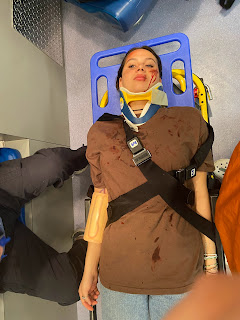Genre Blog: Horror
Common Lighting- Uplighting, Silhouettes, Prominent Shadows
- Uplighting creates weird shadows around the eyes and distorts faces, light from below looks unnatural. So, it creates an immediate alarm.
- Silhouettes add a bit more to this distortion because it plays upon the human fear of the unknown.
- Shadows obscure or conceal subjects in your image which creates mystery, tension, and suspense, because though you can see some of what’s on-screen, you can’t see all of it.
- They produce a complete distortion of the real world.
- The common theme among all different lighting methods is that they all obscure or distort reality in some way.
- Hand-held shots are used very often in horror films to add a sense of reality, it adds to the horror of the scene as you feel like you are there.
- Low angles shots are powerful in the way, they can emphasize just how scary or intimidating a villain is.
- Close-ups are used to see the reactions on the actors' faces. This is a shot that shows the most emotion from a character and deatails.
- Bird's eye/High angle- These kinds of shots are used in horror to make the figure or object that is being looked down upon seem completely powerless.
- Tracking/Panning shots-These shots connote movement. This was used very effectively in horror films to make out characters being followed or watched. While the camera is moving the suspense builds up. So you don't know what will be shown next.
- Tilted Angle- Tilt angles add a lot more tension to shots. While pushing or moving the camera as well. It also acts as though the camera is the victim on the floor, and you're seeing what they're seeing.
- A good storyline is needed as in any genre. Yet in horror, it adds to the narrative more within the movie.
- 5 main parts needed are fear, surprises, suspense, mystery, and essence of terror by connecting to the audience.



Comments
Post a Comment